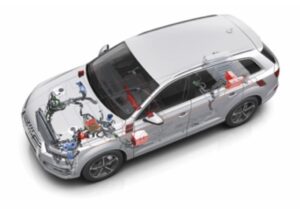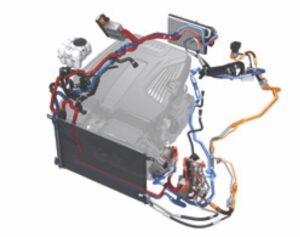Audi Q7 debuts cutting-edge heat pump tech
- PostedPublished 21 May 2016
Audi’s Q7 e-tron made headlines last year upon its unveiling at the Geneva motor show, billed as the world’s first TDI plug-in hybrid with quattro drive and the first plug-in hybrid with a diesel engine from the German prestige marque.
With a 3.0-litre six-cylinder oil-burner and electric motor on-board, the big SUV emerged with 275kW of power, 700Nm of torque, handy acceleration from 0-100km/h (requiring just 6.0 seconds), 56km of electric driving range (via a 17.3kWh lithium-ion battery), total range of 1410km and, not least of all, superb combined-cycle fuel economy of just 1.7L/100km.
Significantly, the Q7 e-tron’s thermal management system with integrated heat pump and three-zone automatic air-conditioning was specifically developed for the vehicle, which is now being rolled out in Europe.
The heat pump’s application has led Audi to claim bragging rights as the first manufacturer worldwide to introduce this technology in series production in a plug-in hybrid, setting a new benchmark – according to the car-maker – in the areas of interior comfort, climate control efficiency and range in EV mode.
The technology makes it possible for the waste heat from the electrical drive components to be made available to the interior of the vehicle, which in turn heats up the cabin more quickly.
In winter conditions, when the outside ambient temperature can be down to zero, the heat pump and electric heater combine to quickly heat the cabin to the temperature set by the driver. From there, Audi says the heat pump alone can maintain a comfortable cabin temperature of around 22 degrees Celsius.
The heat pump has the added benefit of keeping the windows clear of condensation in damp weather, cooling the air to remove the moisture and then heating it back up again without combining with the electric heater. According to the car-maker, conventional heating systems in electric-drive vehicles need to use energy twice to achieve the same result.
Audi also says the technology allows the electric driving range to be extended by up to 20 per cent. Even more range can be achieved if the owner pre-conditions the cabin temperature before driving off, while the car is still under charge.
The system might be complex but it was developed along similar principles to large-scale refrigeration equipment in which mechanical power can be converted into a useable flow of heat via a circuit process incorporating the phases of compression, heat extraction, expansion and heat absorption.
On the Q7, the heat pump gathers waste heat from the components in the electric drivetrain and raises it to a higher temperature. Engineers claims that up to 3kW of heating power from 1kW of electric power can be generated.
The heat pump is connected to three refrigerant circuits in which temperatures can vary from -20 to 110 degrees Celsius.
The high-temperature circuit supplies the engine and transmission, the low-temperature circuit cools the electric motor and its power electronics, while another circuit cools the battery and the charging device, and can be coupled to the air-conditioning system and the electric motor’s LT circuit.
Developed in-house and first used on the prototype R8 e-tron, the heat pump is expected to be incorporated into other plug-in hybrids from Audi and the broader Volkswagen Group, with the technology making its way through the industry as hybrids continue to push towards the mainstream in parallel with manufacturers’ efforts to reduce fuel consumption.
- CategoriesIn SightGlass
- TagsAudi, heat pump, HVAC, Hybrid, PHEV, plug-in hybrid, SightGlass News Issue 6





